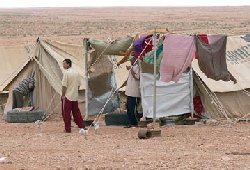In the past few years, the Palestinians' 61-year-old tragedy has been given a new dimension.
The Palestinian refugees of Iraq, who became victims of persecution and violence before being chased from their Baghdad homes after the US invasion of Iraq in 2003, are among the world's most vulnerable communities.
The tents of al-Waleed camp in the deserts of Iraq near the Syrian border offer the only home to about 1,500 Palestinian refugees who had been living in the Iraqi capital.
The isolated camp was set up in 2006 by the refugees themselves as they had nowhere to flee to except the closest no-man's land.
Precarious conditions
The stranded refugees live in precarious conditions and have been unable to gain entry into any neighboring Arab country.
Residents say they have been harassed and persecuted by armed groups as well as US and Iraqi forces since the fall of Saddam Hussein's government.
According to the International Organization for Migration (IOM), there are about 34,000 Palestinians in Iraq.
As many as 23,000 of them are registered with the UNHCR, the UN refugee agency, in Baghdad.
The Palestinians' flights to Iraq occurred mainly in 1948, 1967 and 1991.
Many of those who arrived in 1948 after the creation of the state of Israel were treated exceptionally well under Saddam's government, causing some Iraqis to resent and envy them.
Some say that immediately after the fall of his government, the refugees began to be seen by Shia groups and government forces as collaborating with Sunni anti-government fighters.
Before the 2003 US-led war on Iraq, Palestinians had been well integrated into society, having Iraqi nationality and full civil rights and even speaking Iraqi dialects.
But as soon as violence and lawlessness reigned in Iraq, armed groups started targeting Palestinians in the Baghdad neighborhoods of Baladiyat, al-Hurriyah and Iskan.
Since March 2006, a steady flow of Palestinians has been leaving Baghdad. People arrive at al-Waleed camp on a regular basis and most come from lower socio-economic backgrounds.
Health problems
These vulnerable people fled the murders of their family members and death threats only to face horrendous conditions in the desert.
The tents are overcrowded and leave residents vulnerable to extreme weather conditions.
The camp suffers from poor hygiene and an absence of medical care amid extreme weather conditions.
Children, women and the elderly have died due to the lack of adequate healthcare.
The nearest hospital is four hours drive' away along a dangerous route.
The tents are overcrowded and many residents have chronic respiratory ailments, high blood pressure, diabetes and heart problems.
Tents fill with water when it rains, and temperatures can fall below freezing in the winter.
In the summer, temperatures above 50C have been recorded, while sandstorms, fires, snakes and scorpions all present dangers.
With no sewage system, waste water runs openly through the camp, leading to a higher occurrence of disease and infections among children who play between the tents.
In November 2008, the camp was moved to a gated area with improved security, running water and electricity and a health clinic employing two doctors.
Children attend a makeshift school on the old site, run by teachers who are also refugees. Isolation from the outside world presents severe schooling difficulties.
The destitute residents remain exclusively dependent on international aid and humanitarian assistance.
Unforgiving location
Desperate to draw international attention to their suffering, the refugees have staged open sit-ins in the past three years, demanding that Arab and international leaders find an immediate and durable solution for them through resettlement in a Western country.
Although there have been some improvements in facilities recently, the tents have not turned into more solid structures due to the fear that such a set-up would encourage permanent settlement and need longer-term solutions in one of the most unforgiving locations of the world.
Last year, the Iraqi ministry of displacement and migration called on all Palestinians at al-Waleed to return to their homes in Baghdad, promising them financial compensation, assistance and protection.
But the ultimate goal of the camp's residents is to get out of Iraq as soon as possible without getting hurt.
The UNHCR has two permanent field staff in the camp, and through its implementing partner, Islamic Relief International, it provides assistance in the form of food, non-food items, healthcare and education.
However, the camp was never meant to be a permanent settlement.
There is an urgent need for these refugees to be resettled in order that they can find security, a permanent living status and rights.
Destination Europe
The UNHCR has conducted a vigorous search for homes for the refugees and is negotiating with a number of countries that might be able to offer asylum.
In 2008 and 2009, 375 people left for resettlement in Iceland, the UK, the US, Denmark, France, the Netherlands and Norway.
Last April, 59 residents were temporarily moved to Romania before being resettled in a third country through the UNHCR, based on an agreement between the Romanian government, UNHCR and IOM.
Another 1,200 refugees are also expected to move to Romania temporarily before being resettled in the US.
The UNHCR is seeking resettlement for all the 433 families living at the camp.
But the goal of relocating every resident by the end of this year remains far from being achieved.
PHOTO CAPTION
Palestinian refugees stranded at Al Waleed camp close to Iraq's border with Syria.
Source: Aljazeera.net


 Home
Home Discover Islam
Discover Islam Quran Recitations
Quran Recitations Lectures
Lectures
 Fatwa
Fatwa Articles
Articles Fiqh
Fiqh E-Books
E-Books Boys & Girls
Boys & Girls  Ramadan
Ramadan Fatwa Audios
Fatwa Audios Month of Mercy
Month of Mercy Women
Women Eed Al- Fitr
Eed Al- Fitr Food Recipes
Food Recipes Videos
Videos

 Prayer Times
Prayer Times












